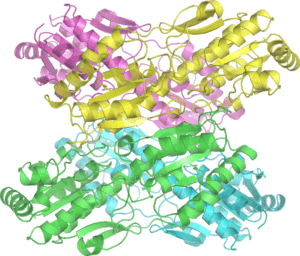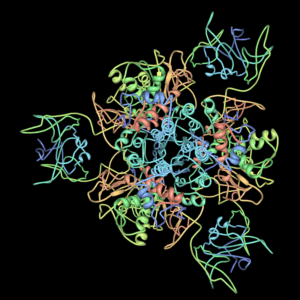Allosteric enzymes change their conformational ensemble when an effector binds to them, resulting in a change in binding affinity at a new ligand binding site. There is a detailed description of allosteric enzyme examples provided.
Allosteric enzymes are a class of biocatalysts that share many of the same properties as enzymes but don’t follow the Michaelis-Menten kinetic model. Their dynamics, on the other hand, are sigmoid.
- Phosphofructokinase (PFK)
- Isocitrate dehydrogenase (IDH)
- Aspartate transcarbamoylase (ATCase)
- Glycogen phosphorylase
- AGPase
- Acetyl-CoA carboxylase
- Pyruvate Kinase
- Ribonucleotide reductase
- glutamine synthetase
- glyceraldehyde-3 phosphate dehydrogenase
- Hexokinase
- glucokinase
- fructose 1,6-bisphosphatase
- pyruvate carboxylase
- Citrate synthase
- Succinate dehydrogenase
- α-Ketoglutarate dehydrogenase
- carbonic anhydrase
- xanthine oxidase
- choline esterase
- nucleoside triphosphates
- methionine synthase
- carnitine palmitoyltransferase 1
- fatty acid synthase,
- Fatty acid amide hydrolase
Phosphofructokinase (PFK)
One of the most significant glycolysis regulating enzymes (EC 2.7.1.11) is phosphofructokinase-1 (PFK-1).

It’s an allosteric enzyme with four subunits that’s regulated by a variety of activators and inhibitors.
Isocitrate dehydrogenase (IDH)
The key control point of the citric acid cycle is catalysed by isocitrate dehydrogenase (IDH). Human IDH is made up of two heterodimers, one of which acts as a catalytic component and the other as a regulatory subunit.
Aspartate transcarbamoylase (ATCase)
The enzyme aspartate transcarbamoylase (ATCase) aids in the flow limit and committed step of pyrimidine biosynthesis.

ATCase is made up of a large catalytic and a smaller regulatory subunit.
Glycogen phosphorylase
In the metabolism of glucose, the enzyme glycogen phosphorylase is crucial. It is responsible for the release of glucose monomers from the glycogen polymer stored in the liver (glycogenolysis). In a process that does not require ATP, GP breaks down glucose to form glucose-1-phosphate (G-1-P).
AGPase
In amyloplasts, AGPase catalyzes the limiting reaction by converting glucose 1-phosphate (Glc-1-P) and ATP to ADP-Glc and inorganic pyrophosphate (PPi) as the first enzyme in the starch production pathway. 3-phosphoglyceric acid (3-PGA) stimulates the enzyme’s catalytic activity, while inorganic phosphate inhibits it (Pi).
Acetyl-CoA carboxylase
Acetyl-CoA carboxylase (ACC) catalyzes the carboxylation of acetyl-CoA to malonyl-CoA, a key intermediate substrate in fatty acid metabolic control.
Pyruvate Kinase
The enzyme pyruvate kinase is involved in the final phase of glycolysis. It catalyzes the transfer of a phosphate group from phosphoenolpyruvate to adenosine diphosphate, resulting in one pyruvate molecule and one ATP molecule.
Ribonucleotide reductase
E. coli’s ribonucleotide reductase is an allosteric enzyme whose activity and specificity are controlled by a complex system of nucleoside triphosphates. Such effectors were found to alter both the Michaelis constant and Vmax values for particular substrates; when multiple effectors were used, the ensuing patterns of activation and inhibition revealed that catalytic activity regulation was extremely intricate.
Glutamine synthetase
In E. coli, glutamine synthetase activity is inhibited by seven different glutamine metabolic end products, including tryptophan, histidine, carbamyl-phosphate, CTP, AMP, glucose-6-phosphate, and NAD+, as well as serine, alanine, and glycine..
Glyceraldehyde-3 phosphate dehydrogenase
Glyceraldehyde 3-phosphate dehydrogenase (EC 1.2.1.12) is a 37-kDa enzyme that catalyzes the sixth step of glycolysis, allowing glucose to be broken down for energy and carbon molecules. Ferredoxin-NADP reductase regulates glyceraldehyde-3-phosphate dehydrogenase.
Hexokinase
When glucose binds to hexokinase, it causes an induced fit conformational change. Physiological amounts of glucose-6-phosphate the product allosterically restrict this conformational change, which precludes ATP hydrolysis.
Glucokinase
Glucokinase (GK) is a monomeric allosteric enzyme that is essential for maintaining blood glucose homeostasis. GK is regulated both directly and indirectly by GK regulatory protein (GKRP) allosteric effectors.
Fructose 1,6-bisphosphatase
A number of tiny molecules, including AMP and fructose-2,6-phosphate, which are negative regulators, and ATP, which is a positive regulator, allosterically regulate the enzyme.
Pyruvate carboxylase
PC is a biotin-containing enzyme that catalyzes the synthesis of oxaloacetate from pyruvate in the presence of an allosteric activator, acetyl CoA. The allosteric activator acetyl-CoA controls the activity of the biotin-dependent enzyme pyruvate carboxylase in numerous species.
Citrate synthase
Escherichia coli’s citrate synthase (CS) is an allosteric hexameric enzyme that is inhibited by NADH. Because the end product of the citric acid cycle, ATP, inhibits citrate synthase, ADP (adenosine diphosphate) acts as an allosteric activator of the enzyme because ATP is produced from ADP. As a result, when the cell has a lot of ATP, the rate of the cycle slows down.
Succinate dehydrogenase
Succinate dehydrogenase (SDH) or succinate-coenzyme Q reductase (SQR) or respiratory complex II is an enzyme complex found in the inner mitochondrial membrane of eukaryotic and many bacterial cells. It’s the only enzyme in the citric acid cycle and the electron transport chain.
α-Ketoglutarate dehydrogenase
The citric acid cycle’s major regulatory point is ketoglutarate dehydrogenase. Its products, succinyl CoA and NADH, block it. A cell with a strong energy charge will also be inhibitive. Allosteric activators of the enzyme include ADP and calcium ions.
Carbonic anhydrase
Carbonic anhydrases are a family of enzymes that can change intracellular and extracellular pH, influencing proliferation, migration, and invasion, as well as contributing to pH gradient inversion.
Xanthine oxidase
Xanthine oxidase is a kind of xanthine oxidoreductase, which produces reactive oxygen species. These enzymes catalyze the conversion of hypoxanthine to xanthine, and they can also convert xanthine to uric acid. In several animals, including humans, these enzymes play a key role in purine catabolism.
Choline esterase
Choline esterase is a member of the esterase family that lyses choline-based esters, some of which are neurotransmitters. [1] As a result, one of two enzymes catalyzes the hydrolysis of these cholinergic neurotransmitters, such as converting acetylcholine to choline and acetic acid.
Nucleoside triphosphates
A nucleoside triphosphate is a molecule with a nitrogenous base attached to a 5-carbon sugar (either ribose or deoxyribose) and three phosphate groups attached to the sugar. A nucleotide is an example of a molecule. They are the molecular progenitors of DNA and RNA, which are nucleotide chains formed during the replication and transcription of DNA. Nucleoside triphosphates are also engaged in signaling pathways and serve as a source of energy for cellular activities.
Methionine synthase
The final step in the regeneration of methionine from homocysteine is catalyzed by methionine synthase. The transfer of a methyl group from 5-methyltetrahydrofolate to homocysteine, yielding tetrahydrofolate and methionine, is carried out by both cobalamin-dependent and cobalamin-independent versions of the enzyme.
Carnitine palmitoyltransferase 1
Carnitine palmitoyltransferase 1 is a protein that facilitates fatty acid transport from the cytosol to the mitochondrial matrix.
Fatty acid synthase
The multi-enzyme protein fatty acid synthase catalyzes the production of fatty acids. It’s not a single enzyme, but rather an entire enzymatic system made up of two identical 272 kDa multifunctional polypeptides that pass substrates from one functional domain to the next.
Fatty acid amide hydrolase
The fatty acid amide hydrolase (FAAH) enzyme is a serine hydrolase that degrades the fatty acid amide family of signaling lipids, which includes anandamide, an endocannabinoid. FAAH’s role in pain and nervous system problems has made it an appealing molecular imaging target.
Also Read:
- Genetic diversity types
- Saprophytic bacteria examples
- Tundra biome examples
- Pathogenic bacteria examples
- Protists cell walls and plant cell walls
- Water movement through cell wall
- Does cytoplasm contains all the organelles
- Monogenea characteristics
- Biome examples
- Is fatty acid polar

Hi…I am Sadiqua Noor, done Postgraduation in Biotechnology, my area of interest is molecular biology and genetics, apart from these I have a keen interest in scientific article writing in simpler words so that the people from non-science backgrounds can also understand the beauty and gifts of science. I have 5 years of experience as a tutor.
Let’s connect through LinkedIn-